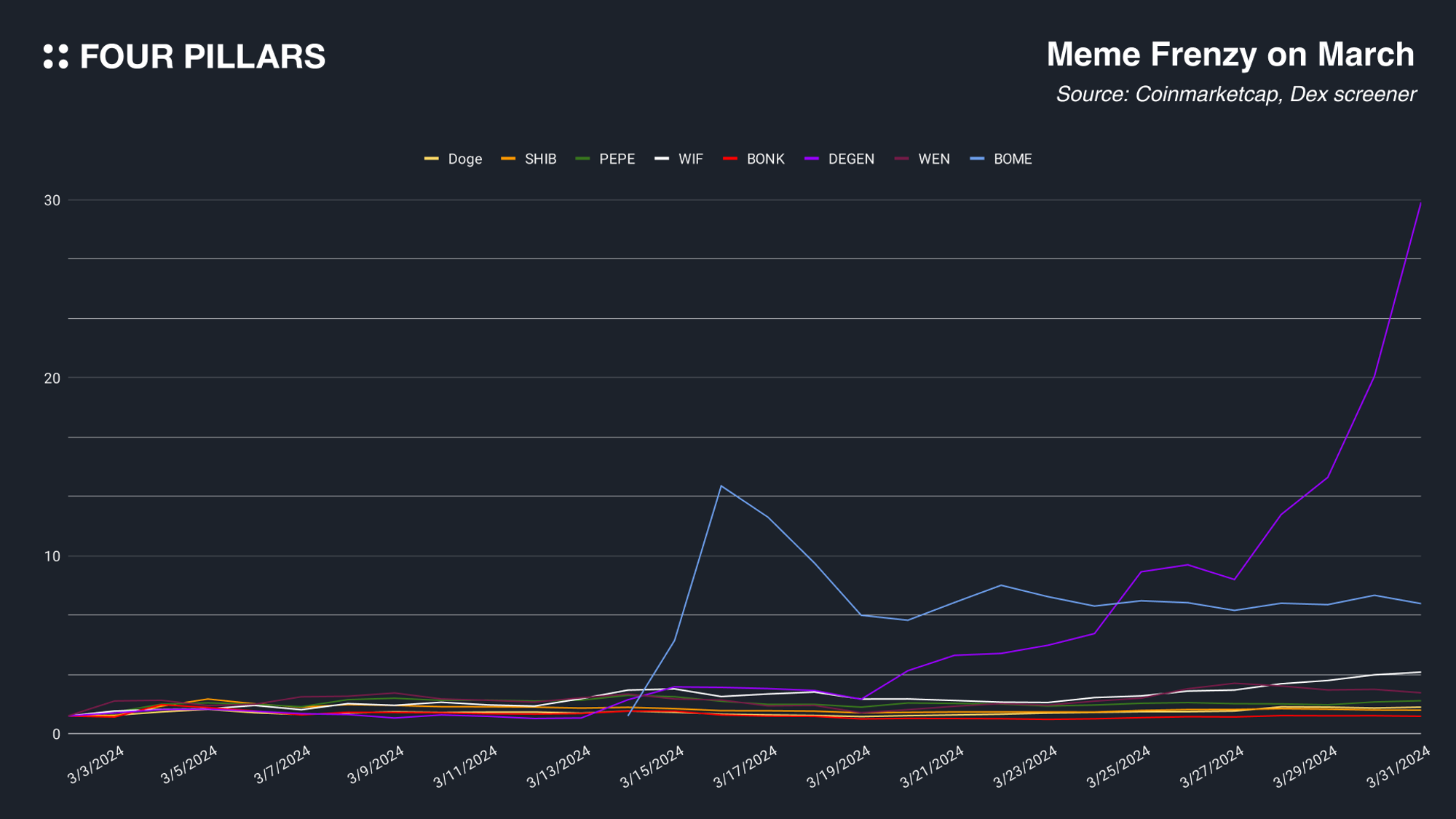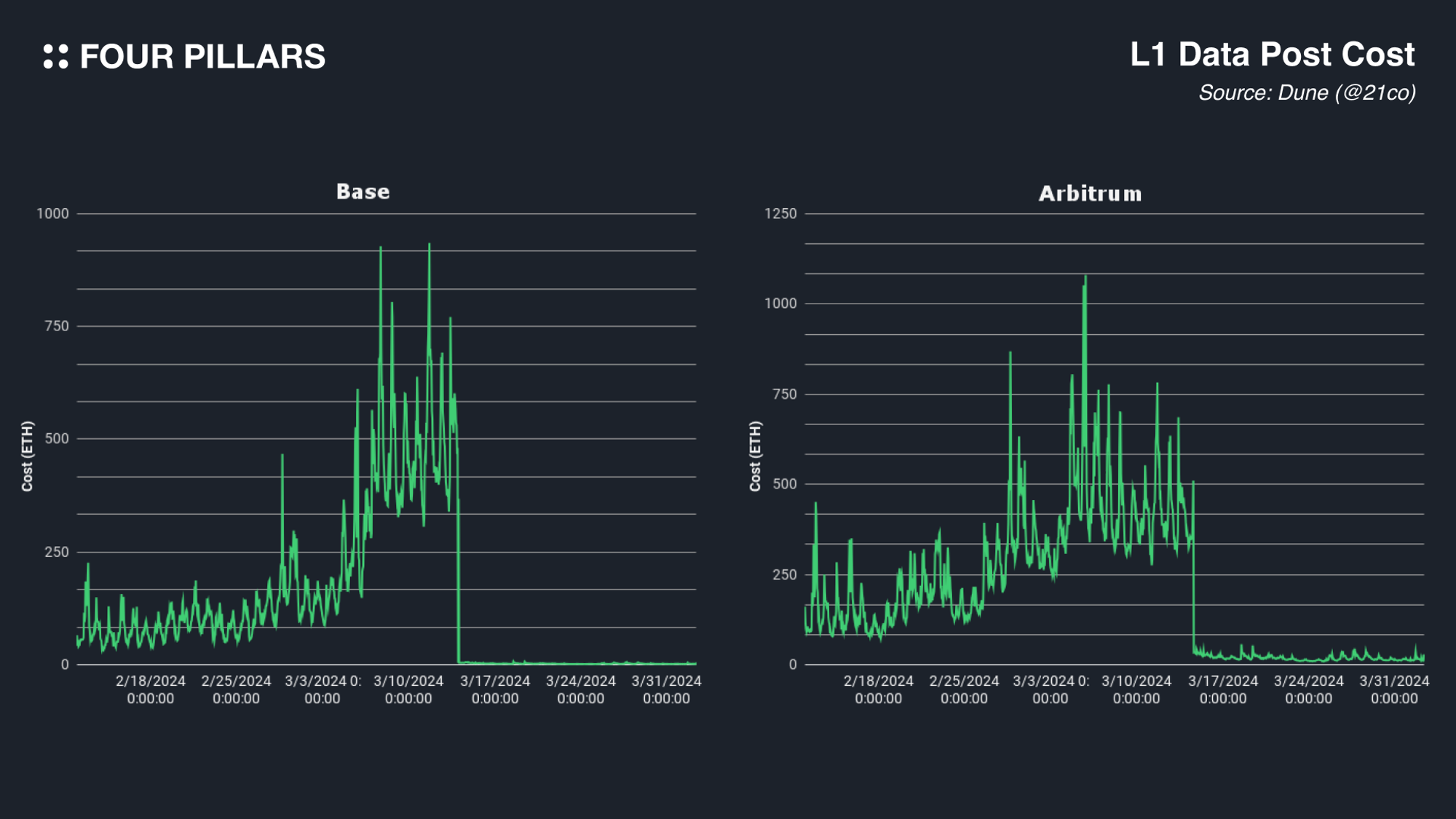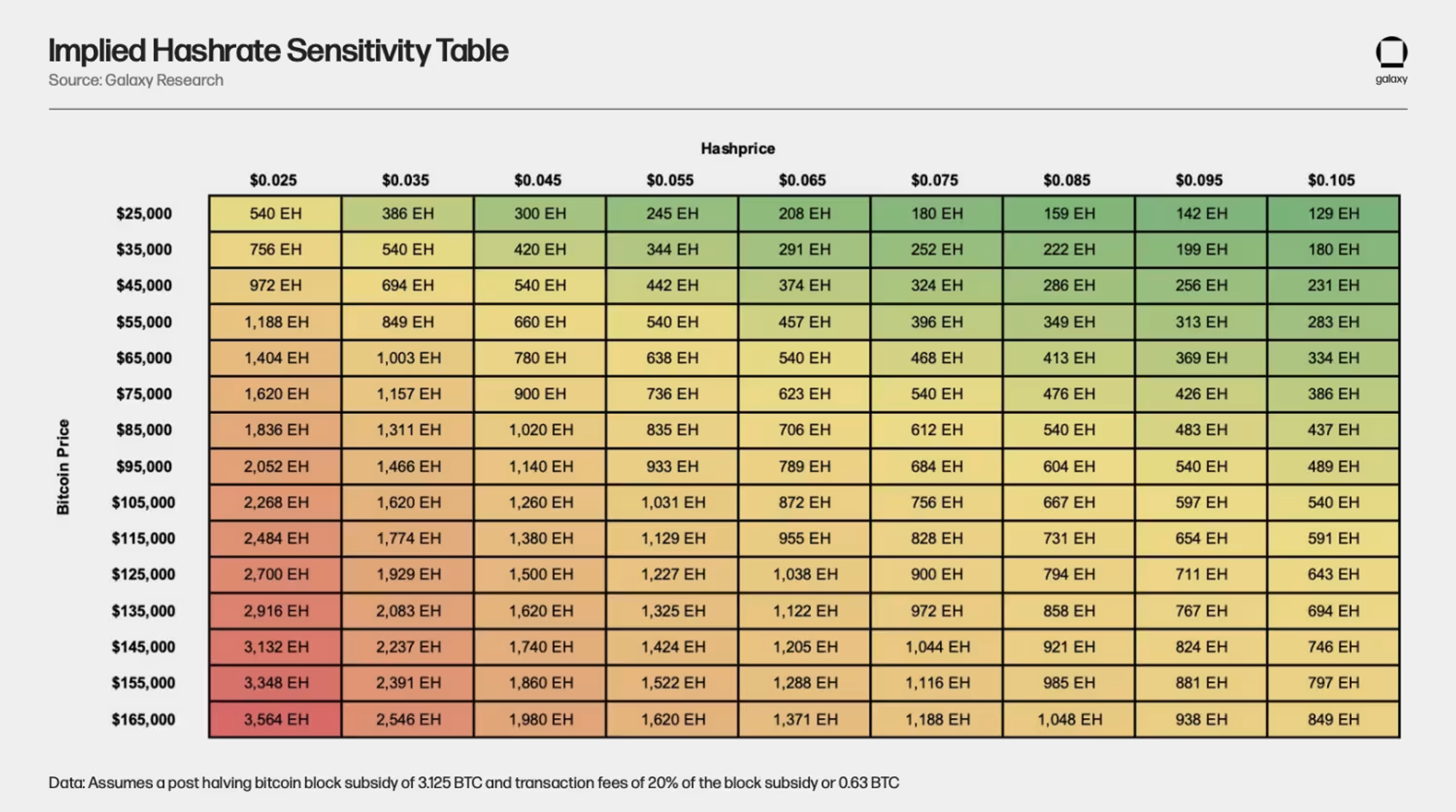

In March, the blockchain market was abuzz with meme tokens. The craze started with established meme tokens like DOGE, SHIB, PEPE, and then shifted towards newer ones in the Solana ecosystem, such as WEN, WIF, BOME, and even to the Base ecosystem's DEGEN. The newer meme tokens, having lower market capitalizations compared to the traditional ones, exhibited much larger price increases. Notably, WIF ranked within the top 30 by market cap, and DEGEN saw an impressive surge of about 30 times its value at the beginning of March, boosted by its popularity on Farcaster.

The case of DEGEN during this meme coin frenzy is particularly noteworthy. Launched in January as a meme token within the Farcaster community, efforts were made to add real utility to DEGEN, such as using it for cookie deliveries. Riding on this momentum, various services within Farcaster began to develop around DEGEN. Eventually, DEGEN collaborated with L3 infrastructure provider Syndicate to use the Arbitrum Orbit through an SDK and launched the Degen L3 network, which utilizes Base for its settlement layer. Degen L3 leverages Arbitrum AnyTrust DAC for data availability and uses DEGEN as its native token. By April 1, Degen L3's TVL reached approximately $11M.

On the 13th of March, 2024, the Ethereum network marked a notable achievement with the successful deployment of the Dencun upgrade. This upgrade, through the adoption of EIP-4844, introduced in a new data storage and fee market called "Blob," offering a cost-effective alternative to the conventional Calldata method for posting L2 transaction data. Aimed at slashing Layer 2 transaction fees, Blobs are priced separately from the ordinary transaction fee market, guaranteeing lower costs for posting data to L1, even in the situation of network congestion. Consequently, Ethereum rollups and their users can now enjoy the benefits of cheaper transaction submissions. Following the implementation of this upgrade on the mainnet, there has been a considerable reduction in data posting costs. Notably, Base and Arbitrum, both of which experience significant demand for their block space, reported post-upgrade L1 data posting fees in the range of 1~2 ETH per day—which is a substantial decrease from the previous average of 500 ETH per day.

Yet, the dramatic reduction in fees triggered an increased demand for block space, subsequently causing fees to rise again. Notably, the Base chain, which recently witnessed a surge in on-chain activities, recorded a transaction volume that was about five times higher post-upgrade. This led to a sharp increase in fees, sometimes reaching pre-EIP-4844 levels. The recent spike in fees is attributed mainly to the L2 sequencers' processing speed limitations, rather than a rise in the cost of submitting data to Ethereum. In response to this heightened demand, Base implemented a strategy to double the gas throughput target for the L2 sequencer through two updates. Despite the ongoing high demand, the single sequencer operation mode of the Base chain suggests that it might be possible to sustain lower fees by enhancing the sequencer's throughput capacity in the near term.
The graph referenced above illustrates that the cost for L1 data submission by rollups has remained consistently low since the upgrade, warranting continued monitoring for future changes. With the recent introduction of inscriptions on Ethereum, there's been a notable increase in the demand for Blob space. Starting from March 27th, inscriptions have occupied over half of the total capacity, keeping the average Blob count per block close to the targeted 3, a figure that influences fee adjustments. While there remains some uncertainty regarding the extent of fee reduction EIP-4844 will achieve for rollups, the observable cost savings have been significant for users, serving as a potent motivator for boosting demand within the L2 ecosystem.

Source: l2beat
Blast L2 successfully launched its mainnet on March 1, and contrary to concerns, its TVL did not plummet but instead showed a trend of increasing and sustaining its value. Typically, projects that bootstrap their ecosystem through deposits and rewards tend to experience a decrease in TVL as initial depositors withdraw funds once withdrawals become possible. However, Blast L2 has set a commendable precedent that other projects can learn from, effectively addressing this challenge.
Firstly, they initiated a phase that accelerated the rate at which rewards were distributed. Following the mainnet launch, the speed of reward distribution significantly increased, providing a strong incentive for initial depositors to keep their funds deposited. Secondly, the project enhanced the user experience by making it straightforward for users to engage with various decentralized applications (dApps) within the ecosystem through a user-friendly UI/UX. The main page of Blast prominently displays a list of ecosystem dApps and overtly communicates that users can earn rewards by using these dApps. This encourages users to explore and utilize their deposited funds across different dApps. Lastly, introducing a new type of reward, named "Gold," in addition to the existing points, has been particularly effective. Gold can be earned not only by making deposits but also by using dApps, offering higher efficiency compared to the regular points and thus motivating users to engage with dApps.
This innovative strategy for ecosystem development by Blast L2 is noteworthy, and it will be interesting to see if the ecosystem remains vibrant and active beyond the anticipated airdrop in May.
Swell Collaborates with AltLayer, EigenDA, and Chainlink to Launch L2 for Restaking with Polygon CDK
Optimism’s permissionless fault-proof system is now on OP Sepolia
Introducing Pilotfish, a new groundbreaking autoscaling technology built on Sui
Ethereum's Pectra upgrade to raise max validator stake to between 32 and 2,048 ETH
Polygon zkEVM blockchain resumes operation following 10-hour outage
Lagrange Labs, Ether.fi Reach $500M Restaking Agreement To Secure Parallel ZK Coprocessing on Ethereum
Introducing zkLink Nova, the industry's first Aggregated Layer 3 zkEVM Network
Introducing "BlobDaddy," open source lightweight DA Aggregator
Citrea is open-sourcing the final element of Citrea, core codebase built on Sovereign SDK
Ankr introduces Neura: A New Era of AI x Blockchain Innovation
Circle’s cross-chain transfer protocol debuts on Solana mainnet
Gnosis unveils uRamp, a groundbreaking on & off ramping solution for the Gnosis Chain ecosystem
MakerDAO founder announces two new tokens in 'Endgame' launch details
ENS data from Etherscan now visible in Google search results
Introducing AnimeChain, in collaboration with Aribtrum and Azuki
Succinct raises $55M led by Paradigm to make zero-knowledge proofs accessible to any developer
Espresso Systems has raised a $28 million Series B round led by a16z crypto
Eclipse Labs raises $50 million in Series A funding ahead of expected Q2 mainnet
Goldman Sachs, BNY Mellon test blockchain network with other firms: Bloomberg
Crypto exchange KuCoin laundered $9B, 'flouted' anti-money laundering laws: DOJ indictment
Fidelity files S-1 application with US SEC for spot ETH EFT with staking
Southeast Asia super-app Grab offers crypto payment options in Singapore
The fourth Bitcoin halving is anticipated to occur around April 21-22, 2024, corresponding to the 840,000th block on the Bitcoin network. This event will reduce the block reward from 6.25 BTC to 3.125 BTC. Due to the reduced pace of new BTC supply, Bitcoin halvings have historically been seen as strong catalysts for price increases, and it remains to be seen whether this halving will also lead to significant price gains.

Source: Galaxy Digital
From the perspective of Bitcoin mining companies, the primary concern is the halving of the basic block reward. Will the profitability of miners remain viable post-halving? The table from Galaxy Digital predicts how the overall network hash rate could be supported after the halving, considering Bitcoin's price and hash price, assuming transaction fee rewards make up about 20% of block rewards. As of April 1, the Bitcoin network's hash rate is approximately 650 EH/s. Galaxy Digital suggests that with current equipment costs, a hash price of $0.035 is considered the break-even point, meaning miner profitability should not be a major issue as long as BTC's price does not fall below $45k after the halving. However, due to differences in equipment and energy efficiency among miners, smaller operations may cease mining or merge with larger companies if they find it unprofitable post-halving.
Looking forward to the post-halving Bitcoin ecosystem, Runes stands out as a significant development. Created by Ordinals inventor Casey Rodarmor, Runes aims to overcome the limitations of the BRC-20 token standard. With numerous projects, such as RSIC and Leonidas's Runestone, preparing for token launches, Runes is expected to become another major source of fee revenue for the Bitcoin network.
The largest sidechain ecosystem for Bitcoin, Stacks, is preparing for the Nakamoto upgrade in alignment with the halving. This upgrade includes several enhancements: transactions on the Stacks network will adhere to Bitcoin's finality, increasing the stability of past transactions; significant improvements in the network's speed; and the introduction of sBTC, a two-way peg system that will allow for trust-minimized transfers between Stacks and the Bitcoin network.
The meme coin frenzy that hit various ecosystems like Solana and Base is now stirring in the Zora network, an OP Stack-based, NFT-focused L2. Zora's founder, Jacob, enabled NFT minting on Zora with the meme token $HIGHER from the Base network, and the network has introduced its first meme token, $ENJOY, which is being used for minting various collections. Despite some mocking the value of meme tokens, their ability to attract funds and users to the Zora L2 suggests they play a significant role in shaping community culture.
BlackRock, the world's largest asset manager, has launched its first tokenized fund, BUIDL, on the Ethereum network. BUIDL holds U.S. Treasury bills and repo agreements, with its price fixed at $1, allowing holders to share in the fund's generated revenues. Ondo Finance has invested $95M in BUIDL, among many other protocols and institutions funneling funds into it, amassing about $275M as of April 1. Despite the declining popularity of Real World Assets (RWA) when the market is favorable, the rapid inflow of funds into BUIDL, closely following the largest on-chain fund, Franklin Templeton's FOBXX ($360M), is noteworthy. The influx of funds into institutional on-chain funds in April will be a key indicator of demand for these financial products.
Thanks to Kate for designing the graphics for this article.
Dive into 'Narratives' that will be important in the next year